WestBend Breadmaker Instruction Manual
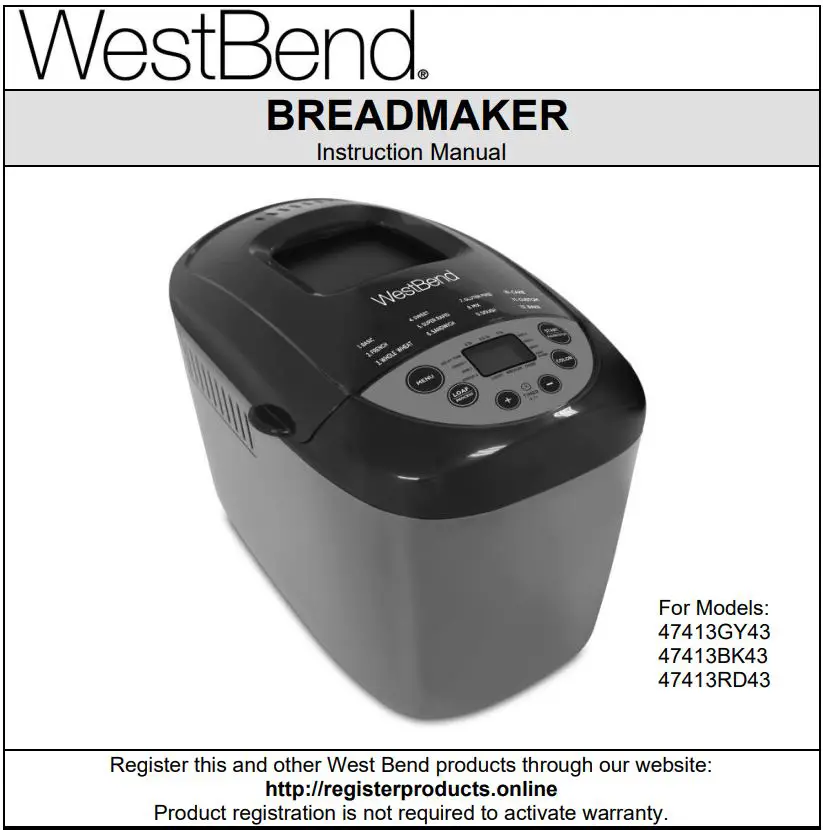
website: http://registerproducts.online
SAVE THIS INSTRUCTION MANUAL FOR FUTURE REFERENCE
© 2020 West Bend®
www.westbend.com
IMPORTANT SAFEGUARDS
![]() CAUTION
CAUTION
To prevent personal injury or property damage, read and follow all instructions and warnings.
When using electrical appliances, basic safety precautions should always be followed including the following:
- Read all instructions.
- Do not touch hot surfaces. Use handle or knobs. Always use hot pads or oven mitts when handling hot bread and bread pan.
- To protect against electric shock do not immerse cords, plugs, or other electric parts in water or other liquids.
- Close supervision is necessary when this appliance is used by or near children.
- Unplug the appliance from the outlet when not in use and before cleaning. Allow cooling before putting on or taking off parts.
- Do not operate any appliance with a damaged cord or plug or after the appliance malfunctions or if the appliance is dropped or damaged in any manner. If you experience any problems with your appliance, unplug it immediately from the electrical outlet. For service, information sees the warranty page.
- The use of accessory attachments not recommended by West Bend may cause fire, electric shock, or injury to persons.
- Do not use this appliance outdoors.
- Do not let the cord hang over the edge of a table or counter, or touch hot surfaces.
- Do not place on or near a hot gas or electric burner, or in a heated oven.
- Extreme caution must be used when moving an appliance during operation.
- To disconnect, turn control to “OFF,” then remove the plug from the wall outlet.
- Do not use appliances other than intended use.
- Avoid contacting moving parts.
- Do not let the cord contact hot surfaces, including the stove.
- This appliance has a polarized plug (one blade is wider than the other). To reduce the risk of electric shock, this plug is intended to fit into a polarized outlet only one way. If the plug does not fit fully into the outlet, reverse the plug. If it still does not fit, contact a qualified electrician. Do not attempt to modify the plugin anyway.
- Set bread pan on a hot pad, trivet, or another heat-protective surface. Do not set the hot bread pan directly on the counter, table, or another surface.
- Do not put your hand inside the oven chamber after the bread pan is removed. The heating unit will still be hot.
- Do not use your breadmaker with a converter or transformer. This will destroy the electronic controls.
- Do not attempt to repair this appliance yourself.
- A short power supply cord is provided to reduce risks resulting from becoming entangled in or tripping over a longer cord.
- Longer, detachable power-supply cords or extension cords are available and may be used if care is exercised in their use. While the use of an extension cord is not recommended, if you must use one, the marked electrical rating of the detachable power-supply cord or extension cord should be at least as great as the electrical rating of the appliance. If the appliance is of the grounded type, the extension cord should be a grounding-type 3-wire cord. The cord should be arranged so that it will not hang over the countertop or tabletop where it can be pulled by children or tripped over.
- For household use only.
SAVE THESE INSTRUCTIONS
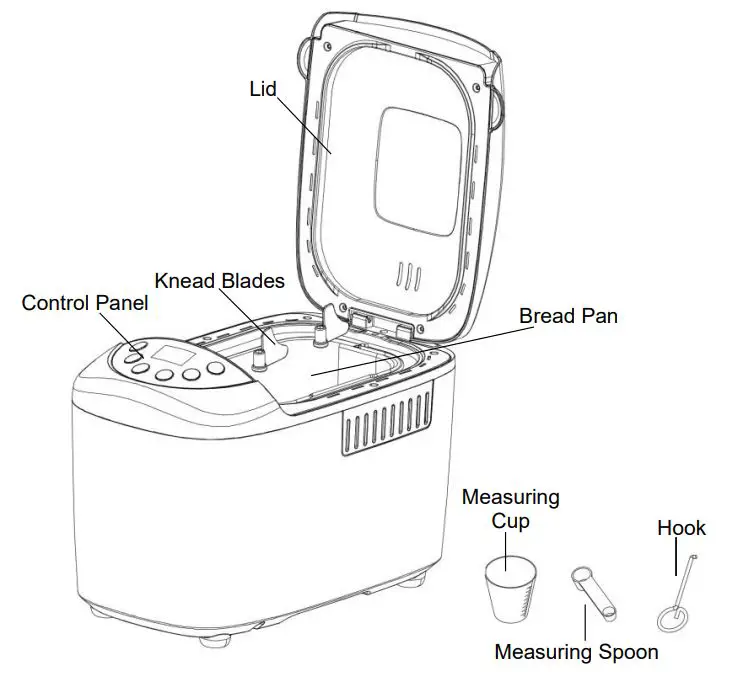
BEFORE USING IT FOR THE FIRST TIME
Check all packaging material carefully before discarding it. Accessory parts may be contained within the packaging material. Remove the plastic film from the display before use. Always clean your new appliance thoroughly before using it; refer to the “Cleaning Your Automatic Breadmaker” section of this manual. Before the first use, add a cup of water to the bread pan and place it in the baking chamber. Leaving the lid open, follow basic instructions to run the breadmaker on the (12) “Bake” setting for one full cycle to burn off any residual manufacturing oils.
Get to know your new West Bend® Breadmaker. The control panel on your breadmaker was designed to be very easy to use. Please review the following features to better understand the control panel.
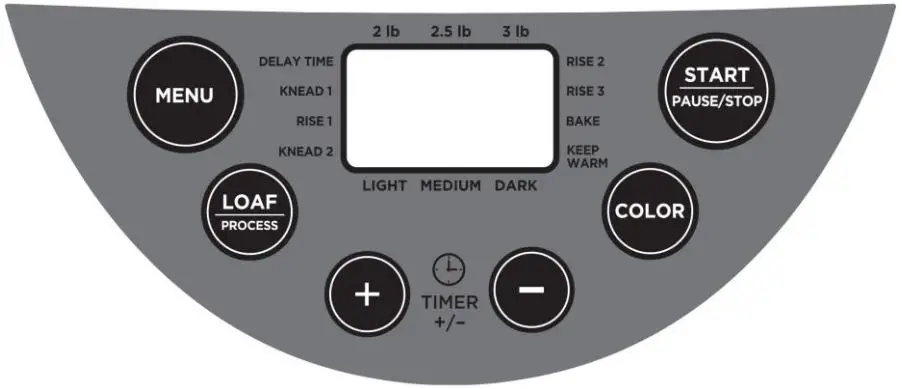
CONTROL PANEL and FUNCTIONS
LCD DISPLAY: The display indicates when the appliance is ready for use. When the appliance is first plugged in, there will be an audible beep and the default program is displayed. “1 3:05” appears on the display. The “1” specifies which program is selected (1-12 programs) and the “3:05” is the length of the program in an hour: minutes. The position of the arrow at the top of the display indicates the weight of the loaf selected (3, 2.5, or 2 lb) with 2.5 lb as the default. The position of the arrow at the bottom of the display indicates the degree of browning that is selected (light, medium, or dark) with the medium as the default. As the program proceeds, the digits of the time displayed will decrease progressively, indicating the remaining time. During operation, the status of the program is indicated in the display with a mark at the active program mode.
“START/STOP” Button: The “START/STOP” button is used to start, pause, or cancel a program. A short alert is heard with each press of the “START/STOP” button. Press this button when the Breadmaker is idle to start the program. When the breadmaker is active, press the button once to pause the program, or press and hold to cancel the program. If you do cancel the program, the breadmaker will return to its default settings for the chosen menu selection. All customized settings will be lost if the program is canceled. You must set all desired program settings before starting the program. The program cannot be changed after the cycle has begun unless you cancel the cycle.
“COLOR” Button: “COLOR” cycles to select the crust darkness: LIGHT, MEDIUM, and DARK. The default color is MEDIUM.
“TIMER” Buttons: The “+” and “-” buttons are used to set a delayed program end time. All settings, except (10) “Cake,” can be used with the delay timer. The delay hours and minutes will be added to the preprogrammed times for the specific program. The time indicated in the display is the time until the end of the cycle. The maximum time delay is 13 hours per program. Note: When delay start time has been selected, press the “START/STOP” button. As time counts down, the “: ” will blink to indicate that it is working. Setting (10) Cake cannot be used with a delayed start.
DELAY START:
The maximum time delay is 13 hours per program. Example: It is 8:30 p.m. and you would like the bread ready for the next morning at 7:00 a.m. Determine the time difference, 7:00 a.m. is 10 hours and 30 minutes ahead of 8:30 p.m. Press the “+” or “-” buttons until 10:30 appears in the display.
NEVER use the time delay function when using perishable ingredients such as milk, eggs, fruit, yogurt, etc.!
“LOAF / PROCESS” Button: The “LOAF” button adjusts the various programs for the selected loaf size; 3 lb, 2.5 lb, or 2 lb. This button is only applicable for the following programs: “Basic,” “French,” “Whole Wheat,” “Sweet,” “Super rapid,” “Sandwich,” “Gluten-free,” and “Cake.”
“MENU” Button: Use the “MENU” button to select the desired program. In general, use the following suggested programs for the following specialties.
MENU SELECTIONS
Menu 1: “Basic” for white, rye, potato, egg, garlic, and similar bread. The “Basic” setting can be used for almost any bread recipe containing mostly bread flour.
Menu 2: “French” for the preparation of particularly light white and Italian bread. This is not suitable for baking recipes requiring butter, margarine, or milk.
Menu 3: “Whole Wheat” for bread containing 50% or more whole wheat, cracked wheat, buttermilk wheat, and like bread.
Menu 4: “Sweet” for preparing bread with raisins, cinnamon, apricots, and similar ingredients.
Menu 5: “Super Rapid” for preparing loaves in under 2 hours. Menu 6: “Sandwich” for baking lightly textured bread with a thinner crust, perfect for at-home sandwiches.
Menu 7: “Gluten-Free” for Gluten-free recipes. Additional bake time on setting 12 may be necessary when baking some gluten-free bread. Always check gluten-free bread’s internal temperature with a thermometer to check doneness.
Menu 8: “Mix” for the preparation of doughs without yeast with no baking.
Menu 9: “Dough” for the preparation of dough with no baking.
Menu 10: “Cake” mix and bake; designed for use with boxed cake mixes and quick bread. Additional bake time on setting (12) Bake may be necessary when baking some cakes or quick bread.
Menu 11: “Custom” this program is for the baker who is very familiar with baking in a bread machine. This program allows for the complete personalization of making bread. The time of each cycle; knead, rise, bake and keep warm, can be customized. The settable time range of each program as following:
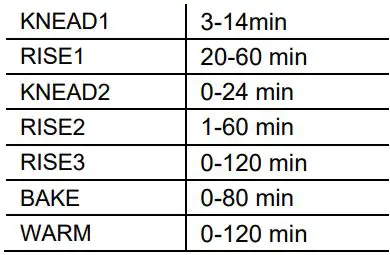
Please see the “Special Instructions for “CUSTOM” “ section for detailed instructions for using the “CUSTOM” function.
Menu 12: “Bake” for baking and browning of bread, cakes, or even casseroles. This setting is perfect for additional baking of bread that is too light or has not baked completely through. Bake time can be set in 10-minute increments, up to 1 hour. Press “LOAF / PROCESS,” then press the “+” or “-” buttons to increase or decrease bake time, then “START/STOP” to begin the cycle. In this program, there are no-knead or rest cycles.
ALERTS, SOUNDS, and OTHER GENERAL FUNCTIONS
Alert: The alert sounds:
- At the pressing of any button that allows function selection. If the button doesn’t beep, that function choice is not available.
- An alert of ten beeps may sound during the second kneading cycle of some settings to signal that the cereals, fruits, nuts, or other ingredients can be added.
- When the end of the program is reached.
- During the warming phase at the end of the baking procedure the alert sounds
several times.
Power Interruption: If there is a brief power interruption of fewer than ten minutes, the program position is stored in the memory and the machine will resume when the power is restored.
Over-temp Error: If the display shows “H: HH” after the program has been started, it means that the temperature inside of bread pan is too high. You should stop the program and unplug the power cord immediately. Open the lid and let the machine cool down completely before using it again.
- A small amount of smoke and/or odor may occur upon heating due to the release of manufacturing oils – this is normal.
- Some minor expansion/contraction sounds may occur during heating and cooling – this is normal.
BASIC STEPS IN MAKING BREAD
Always clean your new appliance thoroughly before using it. Refer to the “Cleaning Your Breadmaker” section.
- Position the knead blades onto the shafts in the bottom of the bread pan, matching the hub shapes with the shaft shapes. You may need to turn the blades slightly for the kneading blades to drop in place. Make sure the kneading blades are pushed down on the shaft all the way. The kneading blade is all the way down when the top of the shaft is flush with the top of the kneading blade.
- Add ingredients to the bread pan in the order listed in the recipe; liquids first, then the butter or margarine, next to the dry ingredients, and finally the yeast. For best results level the dry ingredients before adding the yeast. Note: Ingredients and measuring are the keys to successful breadmaking. We highly recommend reading the “Know Your Ingredients and Other Helpful Hints” section of this manual before making bread.
- Insert the bread pan; place the bread pan in the center of the baking chamber. Press gently on the bread pan to lock the pin into place. To remove the bread pan, pull with medium force on the bread pan carrying handle. CAUTION: The handle is hot after baking. Use oven mitts or hot pads when removing a hot bread pan.
- Close the lid. Plug the breadmaker cord into a 120 volt, AC electrical outlet ONLY.
- Use the “MENU” button to select the desired program menu. (see pg. 5)
- Use the “LOAF / PROCESS” button to select the desired loaf size.
- Use the “COLOR” button to select the desired crust darkness.
- If desired, use the TIMER “+” and “-” buttons to set the elapsed time for when the program is to be completed (see pg. 4).
- Press the “START/STOP” button to begin the program. After the breadmaker has been turned on, the programmed setting cannot be changed without canceling the program. To change the setting, hold the “START/STOP” button down until the alert sounds; program the control as desired and turn it back on.
- When the bread is done, an alert will sound. Turn the breadmaker off by holding the “START/STOP” button down until the alert sounds. Unplug the cord from the electrical outlet. If the breadmaker is not turned off after the cycle is complete, the breadmaker will automatically go into a one-hour “Keep Warm” period. If the machine is not turned off after the end of the “Keep Warm” period, the machine will turn itself off.
- Remove the bread pan. CAUTION: The handle is hot after baking. Use oven mitts or hot pads when removing a hot bread pan.
- Invert the bread pan and shake gently until the loaf falls out. Place the bread on a rack to cool for 15 to 20 minutes. The knead blades will normally stay in the bread pan when the bread is removed, but may on occasion slide out in the bread. If a kneading blade is inside the loaf, remove with the included hook before slicing. CAUTION: The kneading blade is very hot, remove with care. If making another loaf of bread right away, be sure the machine is turned off, unplugged, and allowed to cool for 15 to 20 minutes with the lid open.
Special Instructions for “CUSTOM”: The “CUSTOM” setting is perfect for the user who is familiar with the intricacies of making bread at home and wants to customize their own settings.
- Press the “LOAF / PROCESS” button once and “KNEAD1” will appear on the display; then press the TIMER “+” and “-” buttons to adjust the minutes. Press “LOAF / PROCESS” again to confirm the time for the first kneading cycle. Press “LOAF / PROCESS” again to advance to the next step. Note: To advance the time more rapidly, press and hold the TIMER “+” and “-” buttons.
- “RISE1” will now show on the display. Press the TIMER “+” and “-” buttons to adjust the minutes. Once the desired time has been set, press “LOAF / PROCESS” again to advance.
- Continue until you have customized all settings. Press “START/STOP” to exit programming, then press again to begin the cycle.
Note: Your breadmaker’s memory can remember your customized homemade settings unless power is lost for more than 5 minutes. When “CUSTOM” is first selected, the default setting is the same as BASIC.
High Altitude Adjustment: Reduced air pressure at high altitudes causes yeast gases to expand more rapidly and the dough to rise more quickly. The dough can rise so much that when it begins to bake, it will collapse due to overstretching of the gluten structure. To slow the rising of the dough, reduce the amount of yeast by ¼ teaspoon at a time until you find the right amount. You can also reduce the amount of liquid by a teaspoon or two. Some experimentation will be needed when using your breadmaker at high altitudes.
CLEANING YOUR BREADMAKER
- Unplug the cord from the electrical outlet and allow the appliance to cool completely before cleaning.
- After the bread is removed from the bread pan, and the pan has cooled, fill it half full with warm water and a small amount of dish soap. Allow the bread pan to soak for 5 to 20 minutes, or until the knead blades can be lifted off of the shafts. You may need to twist the knead blades slightly to loosen. If the kneading blades are difficult to remove after soaking, secure the crossbar on the underside of the bread pan while twisting the knead blades to loosen. Wash the inside of the bread pan and knead blades with a soft cloth, rinse and dry. Use a mild detergent. Never use chemical cleaning agents, oven cleaners, abrasive scouring pads, or cleansers on the bread pan or knead blades, as damage to the coating or finish can occur. Replace the knead blades on the shaft.
- Never immerse the bread pan in water or wash in an automatic dishwasher as damage to the bearing that turns the kneading blade can occur. Wipe the inside of the oven chamber and the outside surfaces of the breadmaker with a damp cloth if necessary. Never dip the appliance in water or fill the baking compartment with water! The lid cannot be removed for cleaning.
NOTE: The coating on the inside of the bread pan may change color over time; this is normal and does not affect the bread.
KNOW YOUR INGREDIENTS AND OTHER HELPFUL HINTS
Although bread making seems very basic, it is a science and the proportions of ingredients are critical. The most important step in using your bread maker is to measure the ingredients precisely and accurately. Read the following information to better understand the importance each ingredient plays in the bread-making process. Always make sure the ingredients are fresh.
- Measure the liquid ingredients in see-through measuring cups
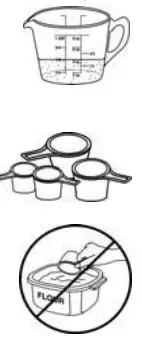 with accurate markings. Place the cup on a flat surface and measure at “Eye Level,” not at an angle. All measurements must be accurate. Always use liquids between 80-90°F (27-32°C) to assure optimal yeast activity.
with accurate markings. Place the cup on a flat surface and measure at “Eye Level,” not at an angle. All measurements must be accurate. Always use liquids between 80-90°F (27-32°C) to assure optimal yeast activity. - Spoon the dry ingredients into the appropriate measuring cups or spoons, and then level off with a table knife. All ingredients measured in measuring spoons and cups must be level, not rounded or heaping.
- Never scoop measuring cups into dry ingredients. This will compress the ingredients into the cup and cause the dough to be dry which will result in a short loaf of bread.
BREAD FLOUR should be used in your bread maker. It contains more gluten-forming proteins than all-purpose flour and will provide well-formed loaves with good structure. Several different brands of bread flour are available. Do not use self-rising or cake flour in your bread maker.
WHOLE WHEAT FLOUR can be used in your bread maker using the “Whole wheat” bread setting. Whole wheat flour contains the entire wheat kernel, including the bran and germ. Therefore, bread made with 100 percent or a high percentage of whole wheat flour will be lower in height and heavier in texture than bread made with bread flour. The “Whole wheat” setting on your bread maker is programmed to better develop the structure of wheat bread for optimum results.
RYE FLOUR can be used in combination with bread flour in the preparation of rye or pumpernickel bread. However, it cannot be used alone as it does not contain enough protein to develop adequate gluten for structure.
SUGAR AND OTHER SWEETENERS provide food for the yeast, add height and flavor to the bread and give the crust a golden color. Types of sweeteners that can be used include sugar, brown sugar, honey, molasses, maple syrup, corn syrup, and fruits, dried or fresh. Do not use artificial sweeteners as a substitute for sugars and other natural sweeteners; artificial sweeteners turn bitter when subjected to baking temperatures, the yeast will not react properly, and poor results will be attained. When measuring sticky sweeteners, such as honey, coat the measuring spoon with vegetable oil before measuring the sweetener. This will allow the sweetener to slide off the spoon without sticking.
MILK enhances flavor and increases the nutritional value of bread. Any type of milk; dry, whole, 2%, 1%, skim, buttermilk, or canned evaporated milk can be used in making bread. Refrigerated milk may be warmed to 80-90°F (27-32°C) however do not overheat (above 100°F, 38°C) as this could affect the yeast activity. Do not use regular milk when using the “Delay Start” function. Use dry milk and water as a substitute.
WATER used in combination with dry milk can be substituted for regular milk and must be used when using the “Delay Start” function as regular milk can spoil when left at room temperature for several hours. Use lukewarm water, about 80-90°F (2732°C). Do not use water above 100°F (38°C) as this could affect the yeast.
BUTTER, MARGARINE, SHORTENING, and OILS serve several purposes in bread making as they tenderize the bread, add flavor and richness. Butter and margarine are interchangeable in recipes. Butter and margarine can be used right from the refrigerator. Cut cold butter or margarine into smaller pieces for faster blending during the knead cycle. Low-fat or fat-free bread can be made by substituting equal amounts of unsweetened applesauce or plain yogurt for the amount of fat recommended in the recipe. Using less fat will affect the height, tenderness, and texture of the bread, which is normal.
EGGS adds color, richness, and leavening to bread. Use only large eggs. No premixing is needed. Egg substitutes can be used in place of fresh eggs. One egg equals ¼ cup of egg substitute. To reduce cholesterol, you can substitute two (2) egg whites for a large egg in the recipes without affecting the end result. Watch the dough during the knead cycle as some minor adjustments may be needed to get the dough to the right consistency.
SALT has several functions in making bread. It controls yeast growth while strengthening the gluten structure to make the dough more elastic and also adds flavor. Use ordinary table salt in your bread maker. Using too little or eliminating the salt will cause the dough to override. Using too much can prevent the dough from rising as high as it should. “Light” salt can be used as a substitute for ordinary table salt, providing it contains both potassium chloride and sodium. Use the same amount as recommended for table salt. When adding salt to the bread pan, add to one corner to keep it away from the yeast, especially when using time delay as the salt can affect the yeast activity.
YEAST is a living organism that, through fermentation, feeds on carbohydrates in flour and sugar to produce carbon dioxide gas that makes the bread rise. Active dry, fast-rising, or bread machine yeast can be used in your bread maker. Use only the amount stated in the recipes. Using a little more can cause the dough to override and bake into the top of the bread maker. Fast-rising yeast and bread machine yeast are virtually the same and interchangeable with one another. Do not use compressed yeast as poor results may be obtained. A ¼-ounce envelope of yeast contains 2¼ teaspoons. Yeast can also be purchased in bulk so you can measure the exact amount needed. Once opened, keep refrigerated. Always make sure yeast is fresh and has not passed the “Use By” date.
SPECIAL NOTE ON FLOUR: All flours are affected by growing conditions, milling, storage, humidity, etc. While not visibly different, you may need to make some minor adjustments when using different brands of flour as well as compensating for the humidity in your area. Always store bread flour in an airtight container. Store whole grain flours, whole wheat, and rye, in a refrigerator, to prevent them from becoming rancid. Measure the amount of flour as directed in each recipe, but make any adjustments after the first 3 – 4 minutes of continuous kneading. You may find you get better bread by weighing your flour rather than measuring in measuring cups. Most flours average 1 cup = 135 grams.
CHECKING THE DOUGH: Making changes to the dough is easy. This can be done during the knead cycle only. Do not turn off the breadmaker to adjust dough.
- Touch the dough. If it feels a little sticky and there is a slight smear of dough under the kneading blade, no adjustment is necessary.
- If the dough is very sticky, clinging to the sides of the pan, and is more like a batter than a dough, add one tablespoon of flour. Allow the flour to be mixed completely into the dough before making any more adjustments. To prevent heat from escaping, open the lid of the bread maker only to add flour.
- If the dough is dry and the bread maker appears to be laboring, add one teaspoon of lukewarm water. Allow water to be completely mixed into the dough before making any additional adjustments and keep the lid closed to keep heat in the appliance.
The dough is “just right” when it is smooth in appearance, soft to the touch, leaves a slight residue on your finger, and the bottom of the bread pan is clean of dough residue.
SPECIAL NOTE ON CINNAMON AND GARLIC: Adding too much cinnamon or garlic can affect the texture and size of the loaf obtained. Cinnamon can break down the structure of the dough, affecting height and texture. Too much garlic can inhibit yeast activity. Use only the amount of cinnamon and garlic recommended in the recipe.
CREATING ARTISAN BREAD CRUSTS: Just before the bread baking cycle begins, open the lid of the bread maker and carefully brush the top surface of the dough with a lightly beaten egg white that has been mixed with 1 teaspoon of water. If desired, slash the top of the dough ¼ to ½ inch deep with a sharp knife into desired design. Leave plain or sprinkle with seeds, herbs, grated parmesan or romano cheeses, or other desired toppings. Press toppings gently into the dough to ensure it adheres and will not fall off. Close the lid and allow the bread to bake. For best results, use only the beaten egg white with water to treat the crust before the bake cycle begins. This mixture will ensure that toppings will stick and not fall off when bread is removed from the pan. Do not use vegetable oil cooking sprays to treat crusts, as the cooking sprays can be
flammable when exposed to the bread maker’s heating unit. The crust can also be treated after the bread is done baking. Remove bread from the bread pan and place it on a rack. Lightly brush the top of the loaf with melted butter, margarine,
olive oil, or vegetable oil and sprinkle desired toppings onto the bread’s top.
GLUTEN-FREE BREAD: Always use room-temperature ingredients. Do not use eggs directly from the refrigerator. Instead, place them in a bowl of warm water until they reach room temperature. Gluten-free bread dough will have more of a muffin batter texture than a typical bread dough texture. This is normal. You may need to assist in mixing the ingredients in your bread pan with a rubber spatula. If you desire a lighter loaf of gluten-free bread, try beer bread or bread made with club soda or ginger ale.
HIGH ALTITUDE ADJUSTMENT: Reduced air pressure at high altitudes causes yeast gases to expand more rapidly and the dough to rise more quickly. The dough can rise so much that when it begins to bake, it will collapse due to overstretching of the gluten structure. To slow the rising of the dough, reduce the amount of yeast by ¼ teaspoon at a time until you find the right amount. You can also reduce the amount of liquid by a teaspoon or two. Some experimentation will be needed when using your breadmaker at high altitudes.
CHECK YOUR TEMPS: It is a good idea at the end of a bread cycle to check the internal temperature of your bread with a thermometer before removing the bread from the pan. Most bread is done when they reach 190°F-200°F. Gluten-free bread should be between 205°F-210°F. If you have not reached these temperatures, it is likely that your bread is underbaked. Bake for additional time on setting (12) Bake.
CYCLE TIME CHART: Please refer to the last page of this manual for a complete breakdown of each
TROUBLESHOOTING GUIDE
Review the following Problems, Possible Causes, and Solutions below.
GLUTEN-FREE TROUBLESHOOTING
Gluten-free breadmaking can be tricky. To prevent baking a dense brick of bread rather than a fluffy loaf, use these helpful tips.
- Use room-temperature ingredients, including eggs.
- Reverse the normal order of adding ingredients. Start with the yeast and dry
ingredients, add half the wet ingredients, and then start the cycle. Allow the ingredients to mix for several minutes and gradually add the remaining wet ingredients. - Observe the dough during the knead cycle. If the breadmaker has difficulty mixing ingredients thoroughly, use a spatula to scrape around the pan to assist.
- Use an instant-read thermometer to take the temperature of your bread before you remove it from the bread pan. If the internal temperature has not reached 205-210°F, your loaf will be underdone. Bake on the bake cycle for additional time, until internal temperature is between 205-210°F.
LOAF SIZE & SHAPE
Short loaves
- Wheat bread will be shorter than white bread due to less gluten-forming protein in whole-wheat flour.
- Not enough liquid – Increase liquid by 1-2 teaspoons.
- Sugar omitted or not enough added – Assemble ingredients as listed in the recipe.
- The wrong type of flour used – Do not use all-purpose flour.
- Not enough yeast used or too old – Measure amount recommended and check the freshness date on the package.
- The wrong type of yeast used – Use fast-rising or bread machine yeast. Do not use compressed yeast.
Flat loaves, no rising - Yeast omitted – Assemble ingredients as listed in the recipe.
- Yeast too old – Check the expiration date.
- Liquid too hot – Use lukewarm liquids 80-90°F (27-32°C).
- Too much salt added – Use the amount recommended in the recipe.
- Sugar or other sweetener omitted – Assemble ingredients as listed in the recipe.
Top and sides cave-in - Too much liquid Reduce liquid by 1-2 teaspoons.
- Too much yeast Use recommended amount.
Gnarly or knotted top, not smooth - Not enough liquid Increase liquid by 1-2 teaspoons.
- Too much flour Measure flour accurately, leveling off measuring cup.
Loaves uneven, shorter on one end - Dough too dry preventing even rise in bread pan Increase liquid by 1-2
teaspoons.
Collapsed while baking - May be caused from baking in high altitude Make adjustment for high altitude
baking by reducing yeast by ¼ teaspoon and reducing the liquid by 1-2 teaspoons.
BREAD TEXTURE
Heavy, dense texture
- Too much flour Measure accurately, leveling off measuring cup.
- Not enough yeast Add the recommended amount of yeast.
- Not enough sugar Add the recommended amount of sugar.
Open, coarse, or holey texture - Salt omitted Assemble ingredients as listed in the recipe.
- Too much yeast Add the recommended amount of yeast.
- Too much liquid Reduce liquid by 1-2 teaspoons.
Bread doesn’t slice well, very sticky - Sliced while too hot Allow bread to cool on a rack at least 15-20 minutes before slicing to release steam.
- Not using proper knife Use a good bread knife or electric knife.
Center of loaf raw, not baked through - Too much liquid Reduce liquid by 1-2 teaspoons.
- Power outage during operation If the power goes out during operation for longer than 5 minutes, the breadmaker will remain off when the power is restored. Remove the unbaked loaf from the bread pan and start over with fresh ingredients.
- Forgot to put knead blade in the bread pan Always make sure the kneading blade is on the shaft at bottom of the bread pan before adding ingredients.
CRUST and COLOR THICKNESS
Dark crust color/too thick
- Too much sugar Reduce sugar by half.
Loaf of bread is burned - Breadmaker is malfunctioning See Warranty page for service information.
Crust too light - Not enough sugar or fat Increase sugar or fat by half the amount recommended.
BREAD PAN PROBLEMS
Knead blade cannot be removed
- Add warm water to the bread pan and allow the kneading blade to soak before trying to remove it. Follow the cleaning instructions. You may need to twist the knead blade slightly after soaking to loosen. Do not immerse the bread pan in water.
Breadsticks to bread pan/difficult to shake out - Can happen over prolonged use Wipe the inside of the bread pan, from the ribs down with vegetable oil or solid shortening. Or add 1 tsp. vegetable oil to the liquid in the bread pan before adding dry ingredients. Do not use the vegetable spray as sticking can worsen. Or, let the bread sit in the bread pan for 10 minutes before shaking out. Replacement bread pans may be ordered. See Warranty section.
MACHINE MECHANICS
Ingredients not mixed
- Did not start machine After programming the control panel, press the “START/STOP” button to turn on.
- Forgot to put knead blade in the bread pan Always make sure the kneading blade is on the shaft in the bottom of the bread pan before adding ingredients.
Burning odor noted during operation
- Ingredients spilled inside the oven Be careful not to spill ingredients when adding to the bread pan as they will turn on the heating unit and cause smoke.
- Bread pan leaks Replacement bread pan may be ordered. See Warranty section.
- The exceeding capacity of bread pan Does not use more ingredients than recommended in the recipe and always measure accurately.
Machine unplugged by mistake or power lost during use for longer than 5 minutes. How can I save the bread?
- If the machine is in knead cycle, reprogram to the same bread setting and turn the machine back on.
- If the machine is in a rising or bake cycle, preheat a conventional oven to 350°F (177°C). Carefully remove the bread pan from the machine and bake on a rack in the center of the oven for 20-25 minutes or until golden brown.
Alert sounds, the display shows “H: HH” and the machine cannot be turned on.
- Breadmaker too hot to make consecutive loaves Unplug the cord from the outlet and allow to cool with the bread pan removed and lid open for 15-20 minutes. Plug the cord back in the outlet, add a bread pan and start the machine. If you are making consecutive loaves of bread, this error message is not uncommon and does not indicate a defect in the bread maker.
Alert sounds, the display shows “E: E0” and the machine cannot be turned on. - Breadmaker is malfunctioning See Warranty section for service information.
RECIPES
Pre-packaged bread mixes can be used in your breadmaker. Simply follow the instructions given for the specific bread mix. Unless otherwise stated for the bread mix, use the 2 lb. setting for loaf size. Follow standard practices; liquid ingredients into the bread pan first, then dry ingredients with the yeast, if required, going in last. Following are some made-from-scratch bread recipes to get you started. A supplemental recipe book is also available at www.westbend.com, in our care and use manuals section under support.
For All Settings: Add liquids to the bread pan first, then dry ingredients. Level the dry ingredients; quarter the butter or margarine and add to the corners. Make an impression in the center of the dry ingredients and add the yeast. Close the lid, select “Menu,” choose setting desired, select “Color,” then select “Loaf” to the size indicated in the recipe. Because of the many variables in bread making, we suggest checking the internal temperature of your bread with a thermometer before removing the bread from the pan at the end of the bread cycle. Most bread is done when they reach 190°F-200°F. Gluten-free bread should be between 205°F-210°F. If you have not reached these temperatures, it is likely that your bread is underbaked. Bake for additional time on setting (12) Bake.
BASIC
The following bread should be baked on setting 1, “Basic.”
Old Fashioned White Bread

Garlic Bread
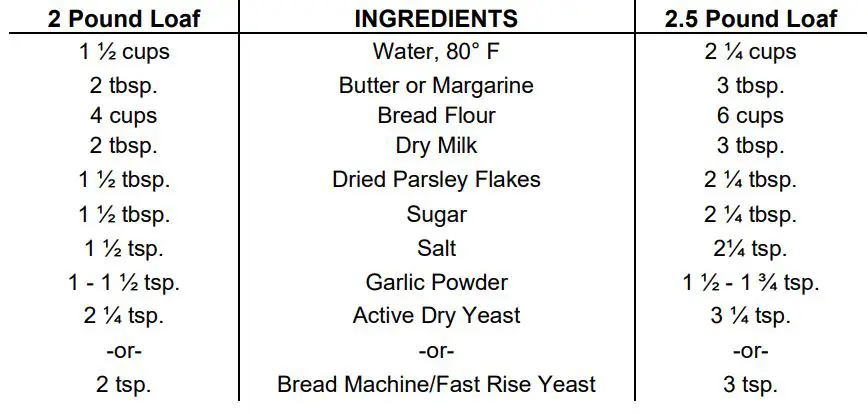
Walnut Bread
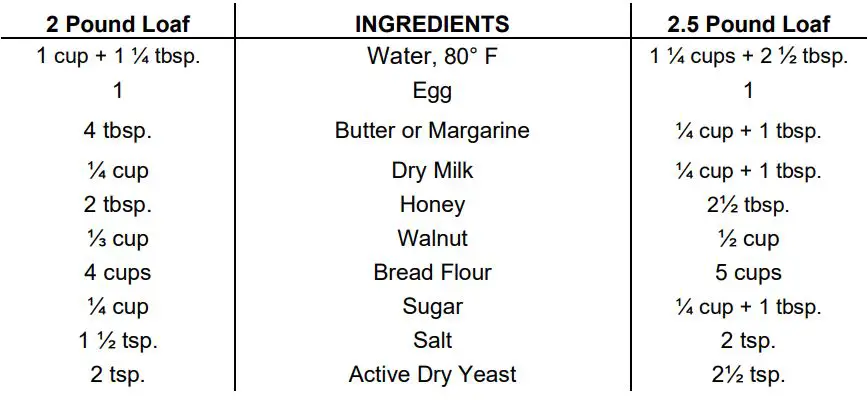
Classic Rye Bread
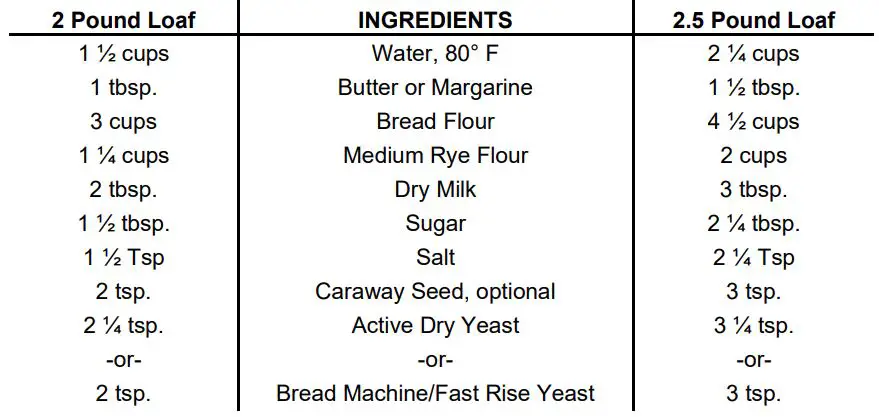
Sesame Bread
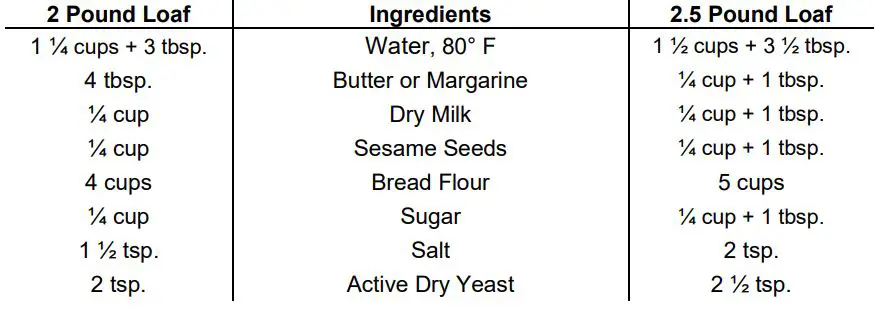
FRENCH
The following should be baked on setting 2, “French.”
French Bread

WHOLE WHEAT
The following recipes should be baked on setting 3, “Whole wheat.”
If the bread collapses during the baking period, add 1 or 1½ tablespoons vital wheat gluten to the recipe for respective loaf size to prevent this from happening. Vital wheat gluten can be found at most health food stores.
100% Whole Wheat Bread
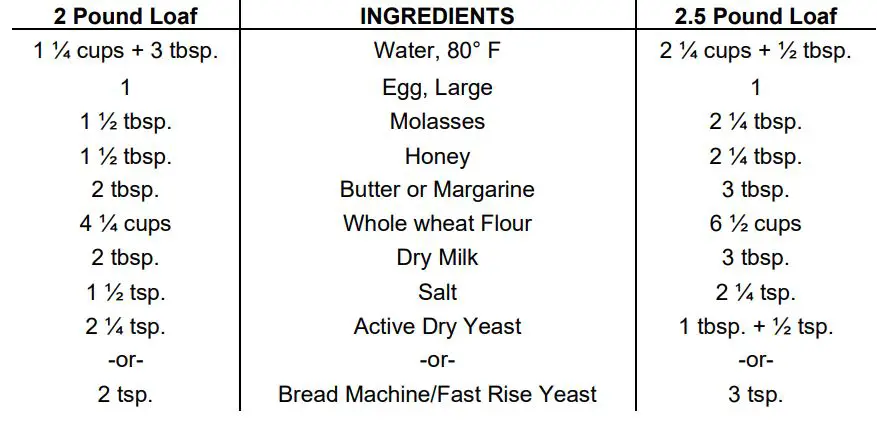
Wheat `N Yogurt Bread
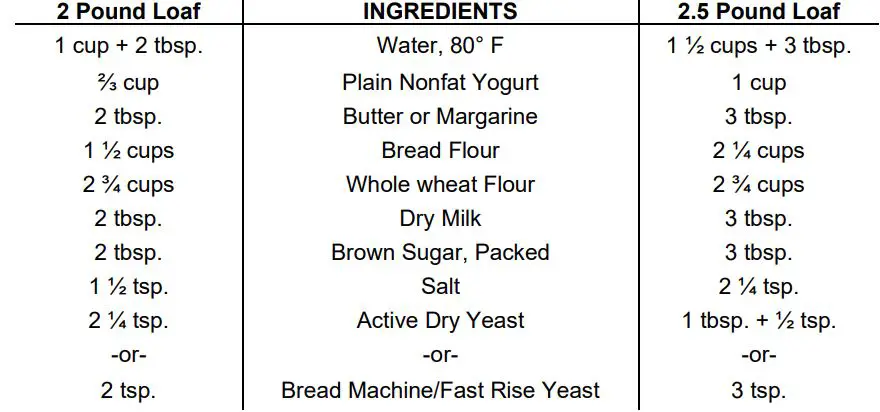
SWEET
The following recipes should be baked on setting 4, “Sweet.”
Nuts can be added at the sound of the alert, or at the beginning with the rest of the ingredients.
Oatmeal Maple Pecan Bread
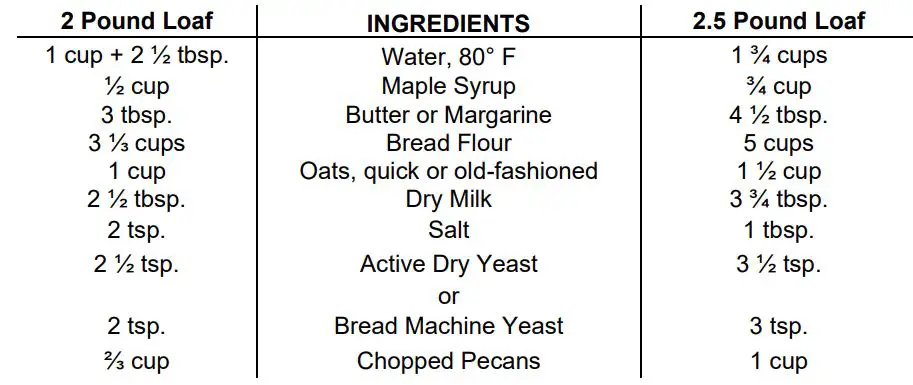
Raisin Bread
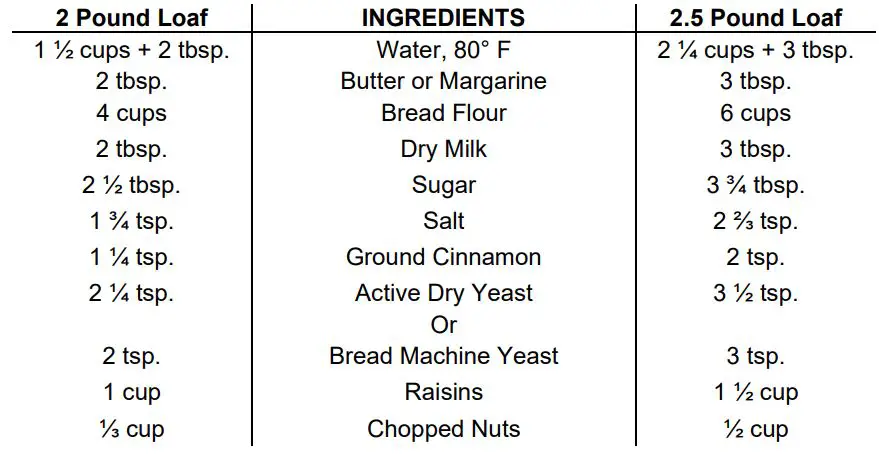
SUPER RAPID
For all of the following recipes, follow these general guidelines. The following should be baked on setting 5, “Super Rapid.” Many recipes can be converted to the Super rapid cycle. Use your recipe of choice and add an additional teaspoon of yeast for those recipes using yeast. DO NOT use any quick bread recipes in this setting.
Basic Super Rapid Bread
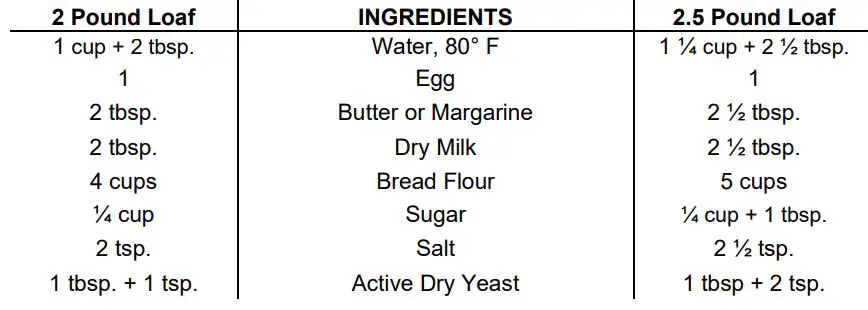
SANDWICH
The following recipe should be baked on setting 6, “Sandwich.”
Sandwich White Bread
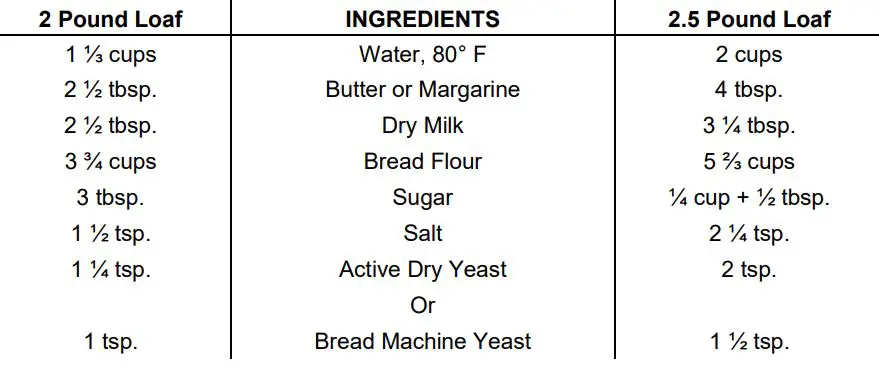
LOW CARB & GLUTEN-FREE
All Gluten-free and Low Carb bread should be baked on setting 7, “Gluten-Free” or setting 11, “Custom.” Gluten-free bread must first have liquid ingredients whisked together in a separate bowl to ensure proper blending. Break eggs into a 2-cup measuring cup and add the recommended amount of water before mixing in the liquid ingredients. Use room temperature ingredients, and if you notice issues with your loaves, reverse the normal order of adding ingredients. Start with the yeast and dry ingredients, add half the wet ingredients, and then start the cycle. Allow the ingredients to mix for several minutes and gradually add the remaining wet ingredients.
Gluten-free Bread
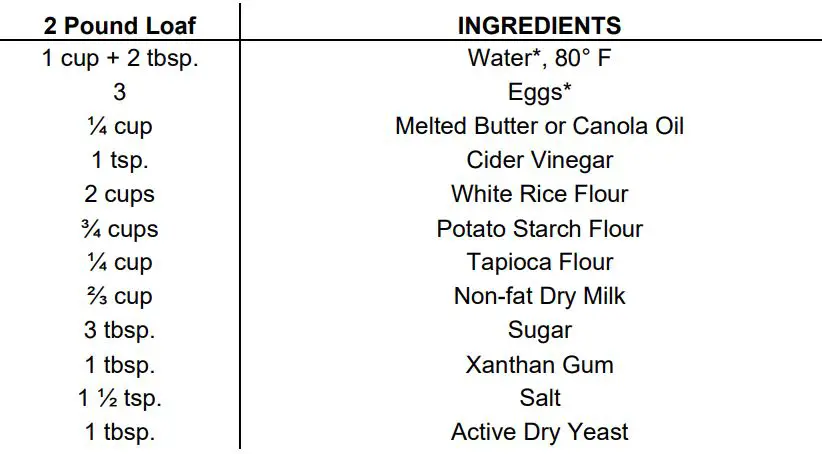
* Place eggs in measuring cup, then add water to the measuring cup, fill to 1 ¾ cup.
Lemon Poppyseed Gluten-free Bread
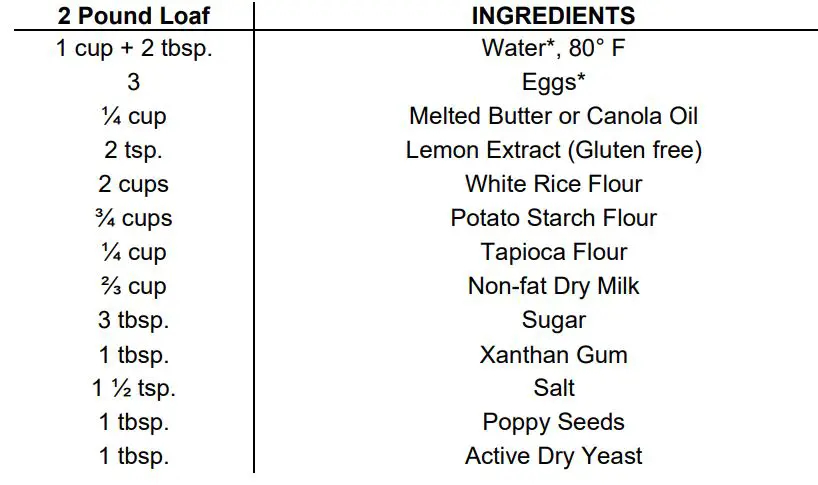
*Place eggs in measuring cup, then add water to the measuring cup, fill to 1 ¾ cup.
Whole Wheat & Seed Low Carb Bread
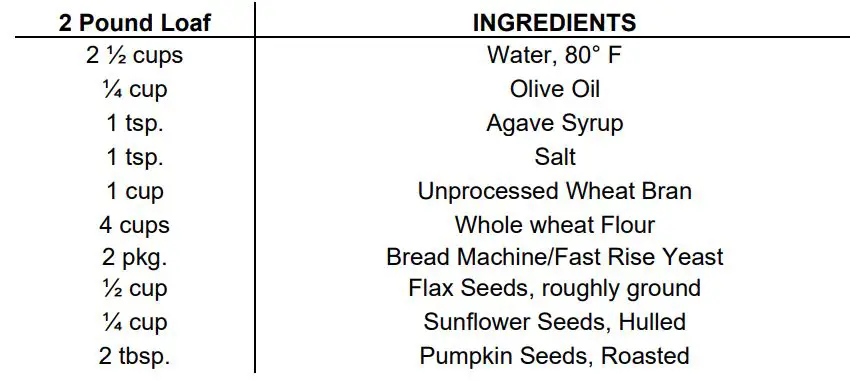
MIX
The following recipes should be baked on setting 8, “Mix.”
Basic Pasta Dough

After knead cycle has completed, remove the dough ball from the bread pan. Place in a plastic bag or under a damp towel to keep moist, and let rest for 30 minutes. Cut into quarters then roll thin through a pasta roller or use a rolling pin to roll to desired thickness.
DOUGH
The following recipes should be set to setting 9, “Dough.”
Pizza Dough
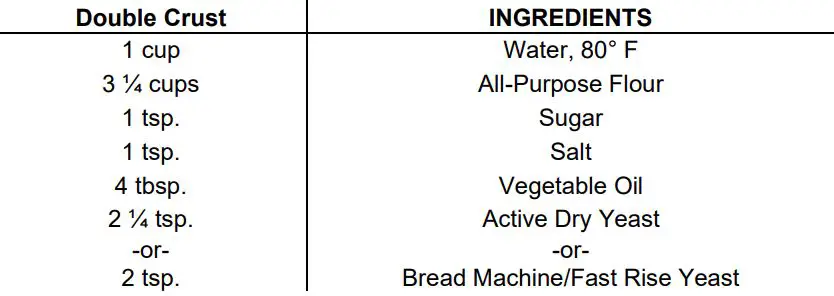
When the dough is done, turn the breadmaker off and remove the bread pan. Place the dough onto a floured surface. Knead for about 1 minute, then let rest for 15 minutes. Roll dough out to fit 12- or 14-inch pizza pans. Place dough on greased pan. If a crisper crust is desired, sprinkle the pan with cornmeal before placing the dough. Press the dough into the pans, forming an edge. Let the dough rise in a warm, draft-free place for 20 to 25 minutes. Spread pizza sauce evenly over crusts, then top with favorite meat, toppings, and shredded cheese. Bake in an oven, preheated to 425°F, for 20 to 25 minutes or until browned on top. Let rest 5 minutes before cutting.
Basic Dinner Rolls/Bread Sticks
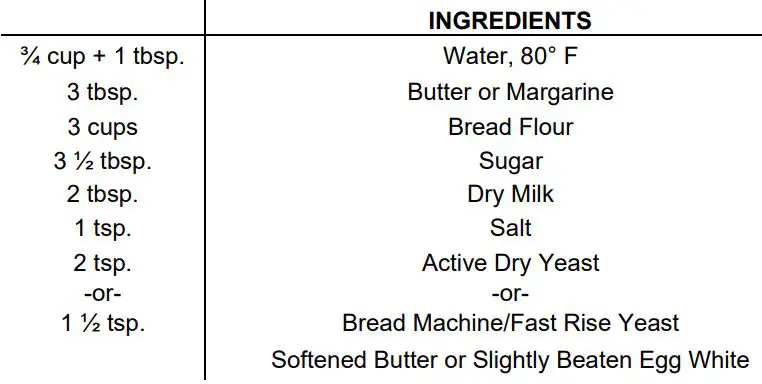
After the dough cycle has completed, remove the bread pan from the breadmaker and then remove the dough. Place dough onto a lightly floured surface for 15 minutes. Shape dough into a desired roll shape, place on a greased baking sheet, cover, and place in a warm, draft-free area for 45 minutes to rise. Once the dough has doubled in size, lightly brush the tops with butter or egg white and bake in a 350° F oven for 15-20 minutes, or until golden brown. Serve warm.
PRODUCT WARRANTY
Appliance 1 Year Limited Warranty
West Bend® (“the Company”) warrants this appliance from failures in the material and workmanship for one (1) year from the date of the original purchase with proof of purchase, provided that the appliance is operated and maintained in conformity with the Instruction Manual. Any failed part of the appliance will be repaired or replaced without charge at the Company’s discretion. This warranty applies to indoor household use only.
This warranty does not cover any damage, including discoloration, to any non-stick surface of the appliance. This warranty is null and void, as determined solely by the Company if the appliance is damaged through accident, misuse, abuse, negligence, scratching, or if the appliance is altered in any way.
THIS WARRANTY IS IN LIEU OF ALL IMPLIED WARRANTIES, INCLUDING WARRANTIES OF MERCHANTABILITY, FITNESS FOR A PARTICULAR PURPOSE, PERFORMANCE, OR OTHERWISE, WHICH ARE HEREBY EXCLUDED. IN NO EVENT SHALL THE COMPANY BE LIABLE FOR ANY DAMAGES, WHETHER DIRECT, INDIRECT, INCIDENTAL, FORESEEABLE, CONSEQUENTIAL, OR SPECIAL ARISING OUT OF OR IN CONNECTION WITH THIS APPLIANCE.
If you think the appliance has failed or requires service within its warranty period, please contact the Customer Care Department at (888) 610-0498, or e-mail us at [email protected]. A receipt proving the original purchase date will be required for all warranty claims, handwritten receipts are not accepted. You may also be required to return the appliance for inspection and evaluation. Return shipping costs are not refundable. The Company is not responsible for returns lost in transit.
Valid only in USA and Canada
REPLACEMENT PARTS
Replacement parts, if available, may be ordered directly from the Company in several ways. Order online at www.westbend.com, e-mail [email protected], or over the phone by calling (888) 610-0498
To order with a check or money order, please first contact Customer Care for an order total. Mail your payment along with a letter stating the model or catalog number of your appliance, which can be found on the bottom or back of the appliance, a description of the part or parts you are ordering, and the quantity you would like.
Your state/province’s sales tax and a shipping fee will be added to your total charge. Please allow two weeks for processing and delivery.
This manual contains important and helpful information regarding the safe use and care of your product. For future reference, attach dated sales receipt for warranty proof of purchase and record the following information:
Date purchased or received as gift: _______________________________________________
Where purchased and price, if known: _____________________________________________
Item number and Date Code (shown bottom/back of product):___________________________
WestBend 30 and 42 Cup Coffee Urns
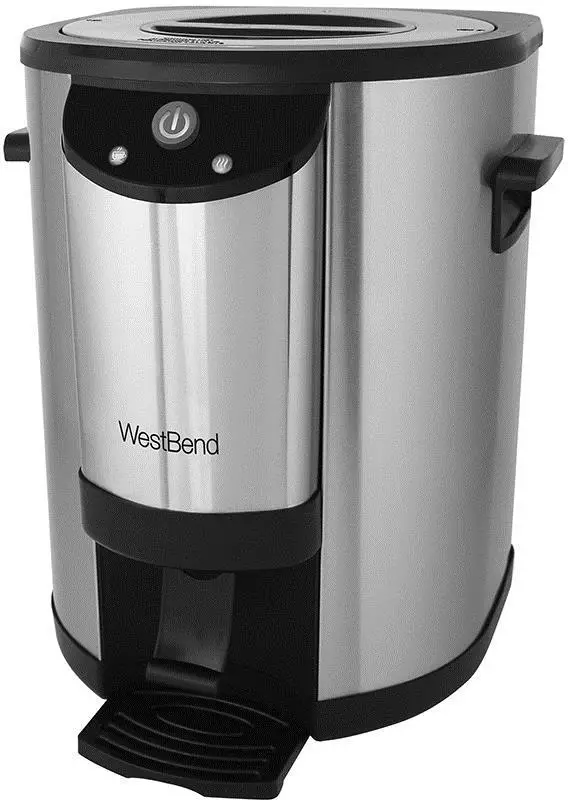
IMPORTANT SAFEGUARDS
To prevent personal injury or property damage, read and follow all instructions and warnings.
When using electrical appliances, basic safety precautions should always be followed including the following:
- Read all instructions.
- Do not use appliance for other than intended use.
- Do not place on or near a hot gas or electric burner, or in a heated oven.
- Do not operate when the appliance is not working properly or when it has been damaged in any manner. For service information see warranty page.
- The use of accessory attachments not recommended by West Bend may result in fire, electric shock or injury to persons.
- Do not attempt to repair this appliance yourself.
- Do not use this appliance on the stovetop, under a broiler, in the oven, or in the refrigerator or freezer.
- Do not touch hot surfaces. Use handles and knobs where provided. Use hot pads or oven mitts when handling hot surfaces.
- Extreme caution must be used when moving an appliance containing hot oil or other hot liquids.
- Make sure cover, basket and stem are properly assembled before the appliance is plugged in (see “Instructions for Making Coffee” section). No part of the appliance should be removed during the brewing cycle as scalding could occur.
- Scalding may occur if the lid is removed during the brewing cycle.
- To protect against fire, electric shock and injury to persons do not immerse cord, plugs, or other electric parts in water or other liquids.
- Do not operate any appliance with a damaged cord or plug.
- Do not use this appliance outdoors.
- Always attach plug to appliance first, then plug cord into wall outlet. To disconnect, turn any control to “OFF,” then remove plug from wall outlet.
- Be sure switch is turned to “OFF” before plugging the cord into wall outlet. If the appliance does not have a switch, be sure the appliance contains water or brewed coffee before plugging in. Do not leave appliance plugged in when it is not being used.
- Always unplug from outlet when not in use and before cleaning. Allow to cool before putting on or taking off parts and before cleaning.
- A short power-supply cord is provided to reduce risks resulting from becoming entangled in or tripping over a longer cord.
- Longer extension cords are available, but care must be exercised in their use. While use of an extension cord is not recommended, if you must use one, ensure that the marked electrical rating of the extension cord is equal to or greater than that of the appliance. If the plug is of the grounded type, the extension cord must be a grounding-type 3-wire cord. To avoid pulling, tripping or entanglement, position the extension cord so that it does not hang over the edge of the counter, table or other area where it can be pulled on by children or tripped over.
- Do not use an outlet or extension cord if the plug fits loosely or if the outlet or extension cord feels hot.
- Keep cord away from hot parts of the appliance and hot surfaces during operation.
- Close supervision is necessary when this appliance is used by or near children.
- Do not let cord hang over edge of table or counter, or touch hot surfaces.
- For household use only.
SAVE THESE INSTRUCTIONS
INSTRUCTIONS FOR MAKING COFFEE
- Before first use, clean coffeemaker thoroughly following cleaning instructions.
- Always use the coffeemaker on a dry, level, heat-resistant surface, away from any edge.
- With the basket and stem removed, fill the coffeemaker with COLD water to the desired cup level. The marks on the inside of the coffeemaker show cup levels. Do not fill past maximum cup level. Never make more than the maximum or less than the minimum amount of coffee, as indicated by the markings inside your coffeemaker, for your model of coffeemaker.
- Place the stem and basket in the coffeemaker. Insert the stem in the opening in the basket then hold the top part of the stem to guide the stem into the heating well in the bottom of the coffeemaker. Use the measuring lines on the basket to add ground coffee to the basket, or use the chart below for the amount to use depending on the cup level. Spread the grounds evenly in the basket. Use standard measuring cups to measure the grounds. Do not let any grounds fall into the stem opening. Do not use finely ground coffee because the basket can flood. The amount of ground coffee recommended will make mild-strength coffee which most people prefer and can be adjusted to suit your preference.
- Place the cover on the coffeemaker, with the vent hole to the back, and turn to lock. Note the arrows on the cover for locking position. Note: While moving an appliance containing hot liquids is not recommended, if you must move the coffeemaker, extreme caution should be used because the cover only temporarily reduces coffee from spilling if the coffeemaker is tipped over.
- Plug the cord into a 120 volt AC grounded electric outlet ONLY. Press the
on/off button. The on/off and “brew” lights will illuminate. - The coffeemaker will stop perking automatically (each cup requires no longer than 1 minute brewing time). Coffee is ready when the green “ready” light glows. Coffee will remain at serving temperature as long as the coffeemaker is plugged in and the power is on. Before serving, remove the coffee basket and stem using a hot pad. If the coffee basket and stem are not removed, bitter oils from the extracted grounds will drip into the coffee. Replace the cover, making sure it is completely locked.
- Press a sturdy cup against the dispensing lever to dispense coffee.
- When about 3 cups of coffee remain in the coffeemaker, press the on/off button to turn the coffeemaker off and unplug the cord from the electrical outlet. Note: Liquid must cover the inside bottom of the appliance at all times. Falling below the minimum level could cause overheating and damage to internal components and will void the warranty.
SPECIAL NOTE ON GRINDING COFFEE BEANS: If you grind your own coffee
beans, grind to medium coarseness for best results. DO NOT grind too fine
(powder-like) as this can cause the basket to flood.
DO NOT make more than the maximum or less than the minimum amount of coffee, as indicated by the markings inside your coffeemaker, for your model of coffeemaker.
| Water Level | Measure of Ground Coffee |
| 42 Cups | 2 ½ Cups |
| 36 Cups | 2 Cups |
| 30 Cups | 1 ¾ Cups |
| 24 Cups | 1 ½ Cups |
| 18 Cups | 1 ¼ Cups |
| 12 Cups | 1 Cup |
INSTRUCTIONS FOR HEATING WATER FOR INSTANT BEVERAGES
Plain water may be heated in your coffeemaker for use with instant beverages. Simply fill the clean coffeemaker with cold water to the desired cup level, insert the stem and empty basket into position the same as for making coffee. Secure the cover in place and plug the coffeemaker in. Press the on/off button. Heat the water until perking stops and the light on the base glows. Remove the cover, lift out the basket and stem with a hot pad, and replace the cover, making sure it is locked in place. Unplug the coffeemaker when less than 3 cups of water remain. The inside of the coffeemaker may darken after heating water, which is normal and does not affect the coffeemaker or the water heated.
Other than making coffee or heating water, no other liquid should be heated in the coffeemaker because damage to the heating unit can occur.
HELPFUL HINTS
- Never make less than the minimum or more than the maximum amount of coffee for your coffee urn.
- Do not use soft water, as flooding of the basket may occur.
- Use regular electric perk grind coffee or coffee ground for all coffeemakers for best results. Do not use finely ground coffee as flooding of the coffee basket can occur. If grinding your own coffee beans, grind to medium coarseness for best results. Do not grind coffee too finely, powder-like, as this can cause the coffee basket to flood.
- Do not use paper filters in your basket. If you find that grounds are falling through, wet the basket before adding coffee grounds.
- Remove coffee basket with grounds as soon as the brewing cycle is completed. This also helps maintain the coffee flavor. Use the coffee maker cover as a drip tray when disposing of wet grounds.
- Liquid must always cover the inside bottom of the appliance at all times. Falling below the minimum level could cause overheating and damage to internal components and will void the warranty.
- A small amount of smoke or odor may occur upon heating due to the release of manufacturing oils – this is normal.
- Some minor expansion or contraction sounds may occur during heating and cooling – this is normal.
- Do not allow ground coffee to fall into the stem.
- If more coffee is immediately desired, partially fill the coffeemaker with cold water to reset the thermostat. Empty the water out of the coffeemaker, then repeat steps 3- 9.
CLEANING YOUR COFFEE URN
- Unplug the coffeemaker and allow it to cool. Drain any coffee out of the coffeemaker.
- Wash the basket, stem, and cover in warm, soapy water with a dishcloth or sponge. Rinse and dry. Coffee stains on the metal can be removed with a non- metallic scouring pad. The basket and stem may be cleaned in an automatic dishwasher, top rack only.
- Clean the inside of the coffee maker by filling with warm water about one-third of its capacity. Add dish soap and wash with a sponge or cloth. Scour the heating unit well (where the stem fits) with a scouring pad. Twist the pad inside the heating unit well to clean. The heating unit well must be kept clean for coffeemaker to work properly. Dispense warm, soapy water through the faucet to clean. Rinse with warm water and dry.
- Clean the outside of the coffeemaker with a damp cloth and dry with a soft cloth. Do not use abrasive metal scouring pads or cleansers on the outside of the coffeemaker because scratching will occur.
SPECIAL CLEANING – EVERY TWO WEEKS
If coffeemaker is used daily, a special cleaning every 2 weeks, or every week if it is used for heating water, is necessary to thoroughly clean the heating unit well. If not kept clean, the coffeemaker will not work properly.
- Fill the coffeemaker with 1 quart EACH of water and white distilled vinegar. (If a white mineral buildup has formed on the inside of coffeemaker, use an additional 2 cups of vinegar). Place the stem and empty basket in place and lock the cover onto the coffeemaker. Press the on/off button. Allow the coffeemaker to complete the perking cycle, then let stand for 20 minutes.
- Press the on/off button to turn the coffeemaker off and unplug the cord from the outlet. Drain the coffeemaker and allow it to cool. Wash the inside and the parts following the regular cleaning instructions, making sure to thoroughly clean the heating unit well.
Product Warranty
]]>WestBend 87906 5-6 qt Slow Cookers

Register this and other West Bend products through our website: http://registerproducts.online
Product registration is not required to activate warranty.
© 2022 West Bend®
www.westbend.com
IMPORTANT SAFEGUARDS
CAUTION: To prevent personal injury or property damage, read and follow all instructions and warnings.
When using electrical appliances, basic safety precautions should always be followed including the following:
- Read all instructions.
- Do not touch hot surfaces. Use handles or knobs and hot pads or oven mitts.
- For countertop use only.
- Always unplug from outlet when not in use and before cleaning. Allow to cool before putting on or taking off parts and before cleaning.
- Close supervision is necessary when this appliance is used by or near children.
- Do not operate any appliance with a damaged cord or plug, after the appliance malfunctions, or has been damaged in any manner. For service information see warranty page.
- The use of accessory attachments not recommended by West Bend may cause fire, electric shock, or injury.
- Do not use this appliance outdoors.
- Do not let cord hang over the edge of the table or counter, or touch hot surfaces.
- Do not place on or near a hot gas or electric burner, or in a heated oven.
- Extreme caution must be used when moving an appliance containing hot oil or other hot liquids.
- To disconnect, unplug cord from electrical outlet letting heating base cool completely before cleaning.
- Do not use appliance for other than intended use.
- To protect against electric shock, do not immerse cord, plugs, or other electric parts in water or other liquids.
- Do not attempt to repair this appliance yourself.
- A short power-supply cord is provided to reduce risks resulting from becoming entangled in or tripping over a longer cord.
- WARNING: Spilled food can cause serious burns. Keep appliance and cord away from children. Never drape cord over the edge of the counter, never use an outlet below counter, and never use with an extension cord.
- Longer extension cords are available, but care must be exercised in their use.
- While use of an extension cord is not recommended, if you must use one, ensure that the marked electrical rating of the extension cord is equal to or greater than that of the appliance. If the plug is of the grounded type, the extension cord must be a grounding-type 3-wire cord. To avoid pulling, tripping or entanglement, position the extension cord so that it does not hang over the edge of the counter, table or other area where it can be pulled on by children or tripped over.
- Do not use an outlet or extension cord if the plug fits loosely or if the outlet or extension cord feels hot.
- Do not use glass cover if it is chipped or has deep scratches. Weakened glass can shatter during use. Discard immediately.
- Do not place glass cover with metal ring in the microwave oven.
- Glass is breakable. Care should be taken not to drop or impact the glass cover. If the cover breaks, it will do so in many pieces. Avoid or discard any foodstuffs exposed to broken cover.
- Be extremely cautious of steam when removing cover. Lift cover slowly, directing steam away from you.
- Set metal cooking vessel and cover on hot pad, trivet or other heat protective surface. Do not set directly on the counter, table or other surface.
- Do not heat covered and empty cooking vessel on top of range. If preheating of cooking vessel is necessary, preheat without cover on.
- Do not allow covered vessel to boil dry on top of range unit.
- Do not set glass cover on hot burner or on oven heat vent. Sudden temperature change may cause the cover to crack or shatter.
- Do not set hot cover on cold or wet surface; let cover cool before placing in water.
- For household use only.
BEFORE USING FOR THE FIRST TIME
Please check all packaging material carefully before discarding. Accessory parts may be contained within the packaging material.
Before using, wash cooking vessel and covers with warm, soapy water, rinse and dry. Wipe non-stick finish of slow cooker heating base with a damp cloth and dry.
USING YOUR SLOW COOKER
- Place heating base on dry, level, heat-resistant surface away from any edge.
- Place foods into cooking vessel, cover and place cooking vessel onto heating base. If you wish to brown or precook any foods before slow cooking, place cooking vessel directly on range top unit over medium heat. After foods are browned or cooked, transfer cooking vessel to heating base. NOTE: Use only plastic, rubber, wooden, or non-metal cooking tools in metal cooking vessel. Use of metal cooking tools will scratch the non-stick surface. Plug cord into a 120 volt, AC electric outlet only.
- Slow cooker base offers heat settings of “WARM,” “LOW,” “MEDIUM,” “HIGH,” and “GRIDDLE.” Heat setting “WARM” should only be used to keep cooked foods warm for serving, whereas “LOW”, “MEDIUM” and “HIGH” are to be used for actual cooking of foods. Set dial directly at setting or anywhere between for complete temperature control. NOTE: DO NOT USE A HEAT SETTING BELOW “LOW” FOR ACTUAL COOKING OF RAW FOODS, AS THE SLOW COOKER WILL NOT GET HOT ENOUGH TO COOK FOODS. DO NOT USE THE GRIDDLE SETTING FOR SLOW COOKING – OVERCOOKING WILL OCCUR.
Select heat setting and cook food for recommended time as given in recipe. As a general guideline, most meat and vegetable combinations need 7 to 10 hours of cooking at “LOW”, 4 to 6 hours of cooking at “MEDIUM” or 2 to 3 hours of cooking at “HIGH”. Meats will become most tender when cooked for the longer time at the lower heat setting. Avoid removing cover when slow cooking, as cooking time will be increased due to loss of heat. Remove cover only when needed to stir occasionally or when adding ingredients.- Some smoke and/or odor may occur upon heating due to the release of manufacturing oils – this is normal.
- Some expansion/contraction sounds may occur during heating and cooling –this is normal.
Care and Use for Insulated Carrying Bag (if included)
- Food must be prepared in slow cooker to retain safe serving temperature during transportation. To help retain this temperature, cover cooking vessel with storage lid and slow cooker cover, place slow cooker in carrying bag and zip closed as quickly as possible.
- Food should not be kept in insulated carrying bag for more than 2 hours to avoid food spoilage. This time will be reduced if bag is kept in a cold area.
- Always use storage lid when transporting slow cooker in carrying bag.
- DO NOT USE STORAGE LID FOR COOKING. Storage lid is designed for use during transporting and/or storage in refrigerator or freezer ONLY.
- Storage lid does not completely seal cooking vessel. Do not overfill cooking vessel as spillage may occur.
- When removing storage lid from heated foods, use care as condensation may form on underside of lid.
- Insulated carrying bag must be completely zipped and carried level to help reduce leaking or spilling.
- Do not put carrying bag or plastic transport cover in any oven.
- Do not plug appliance into an electrical outlet while the slow cooker is still in the carrying bag or has the plastic transport cover on.
To Use
- Unzip insulated carrying bag and open cover. Position interior straps with one to the front and one to the back.
- Remove cooking vessel, set on heat-resistant surface. Remove slow cooker glass cover and carefully place storage lid onto cooking vessel.
- Place heating base in carrying bag, covered cooking vessel on base and slow cooker glass cover on top of storage lid.
- While securing slow cooker cover, carefully lift back strap over covered slow cooker, being sure to go over top knob of cover if featured on your slow cooker. Bring front strap up, insert clip in notch of back strap, securing slow cooker in carrying bag.
- Close cover and zip bag closed. Bring exterior handles around bag and secure with Velcro strap.
- Upon arrival at destination, remove slow cooker from insulated carrying bag. Remove storage lid and replace with the glass slow cooker cover.
Plug into electrical outlet and heat at “WARM” for serving.
HELPFUL HINTS
- Adapting Recipes to Slow Cooking: Many of your favorite oven and range top recipes can be adapted to slow cooking with a few minor changes. Here are some important points to remember:
- Amount of Liquid: Because little moisture evaporates during slow cooking, reduce amount of liquid in your recipe by one-half (1 cup of liquid is enough for most recipes). For soup recipes, add all ingredients except water or broth to vessel; add only enough liquid to cover ingredients.
Amount of Seasoning: Reduce amount of seasoning in proportion to reduced amount of liquid. Use whole or leaf herbs and spices rather than crushed or ground forms. - Slow Cooking Meat: Less tender, less expensive cuts of meat are better suited to slow cooking than expensive cuts of meat. Remove excess fat before slow cooking if desired. Meat can be browned in the cooking vessel on top of the range before slow cooking.
- Slow Cooking Vegetables: Add partially frozen vegetables, Chinese vegetables and fresh mushrooms during the last hour of cooking. Strong-flavored vegetables such as spinach, eggplant, okra and collard greens should be precooked before adding to cooker. The amount of onion normally used in your recipe should be reduced because its flavor gets stronger during cooking. In most cases, fresh vegetables take longer to cook than meats because liquid simmers rather than boils.
- Slow Cooking Raw Meats and Vegetables: Most raw meat and vegetable combinations need at least 2 to 3 hours of cooking at “HIGH” or 7 to 10 hours at “LOW”.
- Slow Cooking Fish and Seafood: Fresh or thawed seafood and fish fall apart during long hours of cooking. Add these ingredients an hour before serving and cook at “HIGH”.
- Slow Cooking Milk, Sweet or Sour Cream and Cheese: Because milk, sour or sweet cream and cheese break down during long hours of cooking, add these ingredients just before serving or substitute undiluted condensed canned soups or evaporated milk. Processed cheese tends to give better results than aged cheese.
- Rice and Pasta: Rice and pasta may either be cooked separately, or added uncooked during last hour of cooking time. If added uncooked, make sure there is at least 1 to 1½ cups of liquid in vessel and heat is set at “LOW” or higher. Dumplings: Dumplings may be cooked in broth or gravy at “HIGH”. Drop by spoonfuls on simmering broth or gravy. Cook covered for 30 minutes.
- Thickening Juices for Gravies and Sauces: To thicken juices for gravies and sauces, add 2 to 3 tablespoons of quick cooking tapioca at start, or thicken after cooking by adding a smooth paste made of 2 to 4 tablespoons cornstarch or flour and ¼ cup cold water. Bring to a boil at “HIGH”. Solid foods may be removed first.
- Amount of Liquid: Because little moisture evaporates during slow cooking, reduce amount of liquid in your recipe by one-half (1 cup of liquid is enough for most recipes). For soup recipes, add all ingredients except water or broth to vessel; add only enough liquid to cover ingredients.
- Don’t Remove Cover During Cooking: To retain heat, moisture and food flavor, don’t remove cover during cooking unless necessary for adding additional ingredients.
- Using Cooking Tools on Non-Stick Finish: The following types of cooking tools may be used on the non-stick finish: plastic, rubber or wooden. Do not use sharp edged metal cooking tools (forks, knives, mashers) as these could scratch the non-stick finish.
- Using Cooking Vessel on Top of Range: The cooking vessel (without heating base) can be used for range top cooking. Place vessel on large burner and use medium to low heat. The use of low to medium heat will prevent foods from overcooking, reduce spattering, and help retain natural juices. Do not use high heat except for bringing liquids to a boil. If cooking on a gas range, do not let flame extend up side of cooking vessel. ALWAYS USE OVEN MITTS WHEN USING COOKING VESSEL AND COVER ON RANGE UNIT.
- Cooking Meats: When cooking meats, preheat empty cooking vessel over medium to medium-low heat for 2 to 3 minutes or until a drop of water sizzles in cooking vessel. To prevent sticking of lean meats, you may wish to add a small amount of cooking oil. Add meat and brown as desired. Cover cooking vessel and reduce heat to low for cooking on range top OR transfer cooking vessel to heating base and cook at desired setting. The shortest cooking time will be at “HIGH”.
- Using Cooking vessel in Oven: The cooking vessel (without heating base) can be used in a conventional or convection oven up to preheated temperatures of 350°F/177°C. Cooking vessel may be covered with aluminum foil for oven use. ALWAYS USE OVEN MITTS WHEN USING COOKING VESSEL IN OVEN.
- DO NOT USE THE COOKING VESSEL IN A MICROWAVE OVEN, OVER A CAMPFIRE OR UNDER AN OVEN BROILER UNIT TO PREVENT DAMAGE TO THE COOKING VESSEL OR OVEN.
- Bread, Cakes & Desserts: Use an 8 x 4-inch or a 9 x 5-inch loaf pan. Check to ensure that your pan fits completely into the cooking vessel before mixing any ingredients. To prevent condensation from dripping onto food while baking, place double layer of paper toweling and single layer of aluminum foil across top of cooking vessel. Cover and bake according to recipe.
TEMPERATURE GUIDE
Be sure to cook foods to recommended food-safe temperatures. Always check with a meat thermometer to ensure that the center is cooked completely. Note: Foods cooked on the light-duty griddle base will take longer than on a standard griddle.
| MEAT | INTERNAL TEMPERATURES | |
| Beef | Rare | 140°F/60°C |
| Medium | 160°F/71°C | |
| Well | 170°F/76°C | |
| Pork | Fresh | 170°F/76°C |
| Smoked | 160°F/71°C | |
| Canned | 140°F/60°C | |
| Lamb | 170°F to 180°F/76°C to 82°C | |
| Veal | 170°F/76°C | |
| Poultry | 180°F/82°C |
CLEANING YOUR SLOW COOKER
- Allow the entire unit (base, cooking vessel, cover) to cool completely before cleaning. Set cooking vessel and cover on dry, heat-protective surface for gradual cooling. NOTE: Do not run cold water over hot glass cover as it may crack or shatter if cooled suddenly.
- Wipe heating base and cord with a damp cloth.
- Cooking vessel and glass cover may be washed using warm, soapy water by hand or cleaned in the dishwasher. If dishwasher cleaning, avoid contact between pieces to prevent damage. Wash storage lid in warm, soapy water, rinse and dry. Lid can also be cleaned in dishwasher, top rack only.
For Travel Accessories, if included:
- Wash storage lid in warm, soapy water, rinse and dry. Lid can also be cleaned in the dishwasher, top rack only.
- Wash insulated carrying bag with mild soap and a damp cloth. Wipe clean and dry completely before storing.
This appliance has no user serviceable parts.
RECIPES
Note: Please pay attention to the size of the recipe you wish to make. Do not attempt to make a 6 quart recipe in a 5 quart cooking vessel.
Beef Vegetable Soup – 5 Qt.
- 1½ lbs. Beef soup bones or 1 lb. beef short ribs
- 1½ qt. Water
- 1 tsp. Salt
- ¼ tsp. Pepper
- 2 Carrots, chopped
- 2 Ribs celery, chopped
- 2 Potatoes, peeled and chopped
- 1 Small onion, chopped
- 1 Bay leaf
- 1 16 oz. Can whole tomatoes, undrained
- Place soup bone, water, salt, pepper, carrots, celery, potatoes, onion and bay leaf into cooking vessel. Cover and slow cook at “LOW” for 6 to 7 hours.
- Remove soup bone and cool slightly. Remove meat from bones and return to soup with tomatoes. Cover and slow cook an additional hour. Noodles or barley may be added, if desired.
Herb Pork Roast – 5 Qt.
- 1 tsp. Salt
- 1 tsp. Thyme
- ½ tsp. Sage
- ½ tsp. Ground cloves
- 1 tsp. Grated lemon peel
- 4-5 lbs. Pork roast, boneless or bone-in
- 4 Large cloves garlic, quartered
- 2 tbsp. Water, optional
- 2 tbsp. Cornstarch, optional
- In small bowl combine salt, thyme, sage, cloves and lemon peel. Rub into pork roast. Cut 16 small pockets into roast and insert garlic pieces.
- Place roast in cooking vessel. Cover and cook at “LOW” for 7 to 9 hours or “HIGH” for 4 to 5 hours. Insert meat thermometer into roast to ensure internal temperature is 170°F/77°C or higher before serving. Allow roast to stand 10-15 minutes before carving. Remove garlic pieces. Juices may be thickened for gravy, if desired. Dissolve 2 tablespoons cornstarch in 2 tablespoons water. Stir slowly into juices until thickened at “HIGH”.
Pepper Steak – 5 Qt.
- 1½ lbs Round steak, cut into thin strips 1 Clove garlic, minced
- 1 cup Chopped onion
- ½ tsp. Salt
- ¼ tsp. Pepper
- ¼ tsp. Ginger
- 1 tsp. Sugar
- ½ cup Soy sauce
- 1 Large green pepper, cut into thin strips
- 4 Tomatoes, cut into eighths, or 1 1-pound can whole tomatoes, undrained 1 lb. Can bean sprouts, drained
- 1 tbsp. Cornstarch
- ½ cup Cold water
- Brown steak in cooking vessel on range unit over medium heat. Transfer cooking vessel to heating base using hot pads.
- In a small bowl, combine garlic, onion, salt, pepper, ginger, sugar and soy sauce. Pour over steak. Cover and slow cook at “LOW” for 6 to 8 hours or “HIGH” for 4 to 5 hours.
- Add green peppers, tomatoes, and bean sprouts, stir to blend. Slow cook an additional hour. Just before serving, increase heat to “HIGH”. Combine cornstarch and water. Gradually add to pepper steak, stirring until thickened. Reduce to “WARM” for serving.
Corned Beef and Cabbage – 5 Qt.
- 3 – 4 lb. Corned beef brisket
- 1 Medium onion, sliced
- ½ tsp. Celery seed
- ½ tsp. Mustard seed
- 1 Clove garlic, minced
- 1 Bay leaf
- Water
- 1 Small head cabbage, cut into wedges
- Place brisket with liquid and spices from package in cooking vessel. Add onion, celery seed, mustard seed, garlic and bay leaf. Add just enough water to cover brisket (about 4 cups). Cover and cook at “LOW” for 7 to 9 hours or until brisket is fork tender.
- During last hour of cooking, add cabbage wedges and continue cooking at “LOW”. Discard cooking liquid and spices.
Hearty Chicken Noodle Soup – 5 Qt.
- 2 lbs. Chicken parts, skinned if desired 5 cups Water
- 1 Medium onion, chopped
- 4 Carrots, cut into ½-inch pieces
- 4 Ribs celery, cut into ½-inch pieces
- 1 16 oz. Can whole tomatoes, cut up
- 1 tbsp. Instant chicken bouillon 1 tbsp. Minced parsley
- 1 tsp. Salt
- ½ tsp. Dried rosemary
- ¼ tsp. Pepper
- 1 cup Uncooked fine egg noodles
- Combine all ingredients, except egg noodles, in cooking vessel. Cover and cook at “LOW” for 6 to 8 hours or at “HIGH” for 3 to 4 hours or until chicken and vegetables are tender.
- Remove chicken pieces from cooking vessel and set aside to cool slightly. Increase heat to “HIGH” and add noodles, stirring to blend. Cover and continue to cook for 30 minutes.
- Meanwhile, remove chicken from bones and cut into bite-size pieces. Return meat to cooking vessel to heat as noodles finish cooking. Reduce heat to “WARM” for serving.
Chili – 5 Qt.
- 1½ lbs. Ground beef
- 1 cup Onion, chopped
- 1 cup Green pepper, chopped 1 Clove garlic, minced
- 1 28 oz. Can whole tomatoes, undrained
- 1 16 oz Can kidney beans, undrained
- 1½ tbsp. Chili powder
- 1 tsp. Salt
- 1 tsp. Ground cumin
- ½ tsp. Pepper
- Brown ground beef with onion and green pepper in cooking vessel over medium heat of range unit. Remove excess grease.
- Transfer cooking vessel to heating base using hot pads. Add remaining ingredients, stir to blend. Cover and slow cook at “LOW” for 7 to 8 hours. Reduce heat to “WARM” for serving.
Slow Cooker Roast – 5 Qt.
- 1 – 3lb Boneless beef chuck roast
- 1 cup Water
- 1 (.7 oz.) packet Italian-style dressing mix
- 1 (.75 oz.) packet Dry brown gray mix
- 1 (1 oz.) packet Ranch dressing mix
- Place the beef roast into the cooking vessel.
- Whisk the water, ranch dressing mix, gravy mix, and Italian dressing mix together until smooth. Pour over beef roast.
- Cover and slow cook at “LOW” for 6 to 8 hours or “HIGH” for 4 to 5 hours.
Fish Chowder – 5 Qt.
- 2 lbs. Fresh or frozen fish fillets
(haddock, perch, cod, flounder) - 2 tbsp. Lemon juice
- 4 Slices bacon
- 1 cup Chopped onion
- ¼ cup Diced celery
- 4 Medium potatoes, cut into cubes
- 4 cups Hot water
- 1 16 oz Can stewed tomatoes
- 1 cup Diced carrots
- 2 tsp. Salt
- ¼ tsp. Pepper
- 1 tbsp. Worcestershire sauce
- 2 tbsp. Dry sherry, optional
- Cut fish into chunks and remove bones. Sprinkle with lemon juice. Cover and refrigerate.
- Fry bacon in cooking vessel on range top over medium heat until crispy. Drain on paper towel, crumble and set aside.
- Sauté onion and celery in bacon drippings until brown. Transfer cooking vessel to heating base using hot pads. Add potatoes, water, tomatoes, carrots, salt and pepper to cooking vessel. Stir to combine. Cover and cook at “LOW” for 4 to 5 hours or at “HIGH” for 2 to 3 hours.
- Drain lemon juice from fish. Add fish, Worcestershire sauce and sherry to cooking vessel. Simmer for 1 hour or until fish flakes easily with fork. Reduce heat to “WARM” for serving. Garnish with crumbled bacon.
Beef Stew – 5 Qt.
- 1½ lbs. Beef Stew Meat, cubed
- 1 med. Onion, Chopped
- 4 med. Carrots, Sliced ½”
- 2 Ribs Celery, Sliced ½”
- 4 med. Potatoes, Sliced ½”
- 1 – 28oz. can Diced Tomatoes
- 1 – 10.5 oz. Beef Broth
- 1 tbsp. Worcestershire Sauce
- 2 tbsp. Dried Parsley Flakes 1 Bay Leaf
- 1 tsp. Salt
- ¼ tsp. Pepper
- 2 tbsp. Quick Cooking Tapioca
- Brown stew meat in cooking vessel on range unit over medium heat. Transfer cooking vessel to heating base using hot pads.
- Add remaining ingredients to cooking vessel. Stir to combine.
- Cover and cook at “LOW” for 8 hours or “HIGH” for 5 hours. Reduce heat to “WARM” for serving.
Country Ribs with Apples ‘N Kraut – 6 Qt.
- 3 lbs. Lean country-style pork ribs, trimmed of any excess fat Salt and pepper
- 1 16 oz Can sauerkraut, undrained 1 Medium onion, thinly sliced and separated into rings
- 1 8 oz Can mushrooms stems and pieces, drained
- 1 Large or 2 small apples, cored and cut into wedges
- ¼ cup Brown sugar
- ½ tsp. Celery seed
- Preheat cooking vessel on electric or gas range top heating unit over medium heat. Add ribs in batches to brown. Season with salt and pepper.
- Return all ribs to cooking vessel. Layer sauerkraut, onion, mushrooms, apple wedges and brown sugar over ribs. Sprinkle with celery seed.
- Place cooking vessel on base, cover and cook at “LOW” for 7 to 9 hours or at “HIGH” for 3 to 4 hours until meat is tender. Reduce heat to “WARM” for serving.
Carrot Cake – 6 Qt.
- 2 cups Flour
- 2 cups Sugar
- 1 tsp. Baking soda
- 1 tsp. Salt
- 1 cup Vegetable oil
- 4 Eggs
- 3 cups Grated carrots
- 1 tsp. Cinnamon
- Grease bottom only of a 9 x 5-inch or 8 x 4-inch loaf pan with solid hydrogenated shortening. Dust with flour and shake out excess. Set covered cooking vessel on base and preheat at “HIGH” while mixing ingredients.
- In mixing bowl, sift flour, sugar, baking soda and salt. Add vegetable oil and stir until ingredients are moistened. Add eggs one at a time, beating well after each egg is added. Stir in grated carrots and cinnamon until evenly mixed. Pour batter into pan. Place pan in cooking vessel.
- Cover and bake at “HIGH” for 2 hours. Do not remove cover during this time. To test for doneness at end of recommended baking time, insert a metal cake tester in several places including center of cake. If cake tester comes out clean, cake is done. If batter clings to cake tester, continue baking in 15-minute intervals. Remove cake from pan and cool on rack. Frost with softened cream cheese, if desired. Makes a 1½-pound cake.
Cranberry Nut Bread – 6 Qt.
- 2 cups (8oz) fresh or frozen cranberries
- ½ cup Walnuts
- 2 cups Flour
- 1 cup Sugar
- 1½ tsp. Baking powder
- ½ tsp. Baking soda
- ½ tsp. Salt
- 6 tbsp. Butter or margarine
- 1 Egg
- 1 tbsp. Grated orange peel
- ½ cup Orange juice
- Grease 9 x 5-inch or 8 x 4-inch loaf pan with solid hydrogenated shortening. Dust with flour and shake out excess. Set covered cooking vessel on base and preheat at “HIGH” while mixing ingredients.
- Grind cranberries and walnuts with coarse blade of food chopper. In a large mixing bowl, combine flour, sugar, baking powder, baking soda and salt. Cut in butter or margarine to form a coarse mixture. Make an indentation in mixture and add egg, orange peel and orange juice. Beat only until lumps disappear. Add chopped cranberries and walnuts. Stir until evenly mixed. Pour batter into pan. Place pan in cooking vessel.
- Cover and bake at “HIGH” for 3 hours. Do not remove cover during this time. To test for doneness at end of recommended baking time, insert a metal cake tester in several places including center of bread. If cake tester comes out clean, bread is done. If batter clings to cake tester, continue baking for 15-minute intervals. Remove bread from pan and cool on rack. Makes a 1½-pound loaf.
Western Omelet Casserole
- 1 bag (32 oz.) Frozen shredded hash brown potatoes
- 1 lb. Bacon sliced, cooked, and drained
- 1 med. Sweet onion, diced
- 1 Green bell pepper, diced
- 1 dozen Eggs
- 1 ½ cup Shredded cheddar or Jack cheese
- 1 cup Milk
- 1 tsp. Salt
- Pepper (to taste)
- Place a layer of frozen potatoes on the bottom of the slow cooker, followed by a layer of bacon then onions, green pepper and cheese. Add another 2 to 3 layers, ending with a layer of cheese. Note: precooked sausage or cubed ham may be used in place of bacon.
- Beat the eggs, milk and salt & pepper together. Pour over the layers in the slow cooker and cover. Cook for 10-12 hours on “LOW” or 3-5 hours on “HIGH”.
PRODUCT WARRANTY

